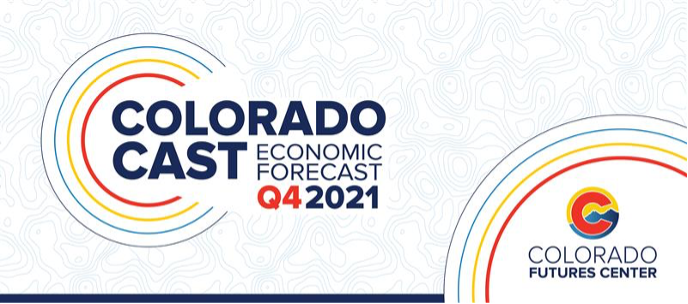Economic activity in Colorado rebounded to its pre-pandemic high in September 2021 and the economy is projected to continue to expand, according to a new quarterly report released by the reestablished Colorado Futures Center at Colorado State University System.
The new forecast, called the ColoradoCast, is a short-term (6 month) economic forecast in the state – it is the only forecast in the state that evaluates data with less than a one-year timeframe, thus filling a gap related to economic data sets released within Colorado.
By April 2022 (the ColoradoCast forecast horizon of 6 months) the Colorado economy is projected to be growing at an annual rate of 6.45%, a slowdown from the more robust annualized rates of growth at the end of 2021, but still a healthy rate of growth relative to the months immediately preceding the pandemic.
While the ColoradoCast projects continued economic growth for the state, unknowns such as the newly emergent Omicron variant pose real and significant risks to the forecast, said Phyllis Resnick, lead economist on the report and executive director of the Colorado Futures Center.
“In comparison with a previously unpublished third quarter 2021 run of the ColoradoCast, the current forecast shows a slight decline in both the size of the Colorado economy and the annualized rate of growth,” said Resnick. “While the slowing in the forecast is slight, it does suggest that the enduring pandemic, along with the emerging supply chain and labor market stresses, over time are presenting modest headwinds to the economic recovery.”
Subsequent forecasts will be released quarterly in February, May, August, and November.
About the ColoradoCast:
The ColoradoCast is a short-term (approximately 6 months ahead) economic forecast for the Colorado economy developed by the Colorado Futures Center, a 501c3 organization dedicated to informing about economic, fiscal and
public policy issues impacting community economic health and quality of life. It is designed to forecast a well-known contemporaneous measure of statewide economic activity, the Coincident Economic Activity Index for Colorado, developed by the Federal Reserve Bank of Philadelphia. The Coincident Economic Activity Index includes four indicators: nonfarm payroll employment, the unemployment rate, average hours worked in manufacturing and wages and salaries. The trend for the index is set to match the trend for gross state product.
The ColoradoCast predicts the value and annualized growth rate in the coincident index using six factors whose predicted relationship with economic activity are as follows (relationship in parentheses): the yield curve measured by the spread between two and ten month treasuries (positive), the risk spread between high quality corporate and ten year treasury returns (negative), employment in the employment services sector (positive), home prices as measured by the Case-Shiller index for Denver (positive), initial claims for unemployment insurance (negative), and the value of the Wilshire 5000 stock index (positive).
The Colorado Futures Center extends a thank you to Dr. Steven Fisher who collaborated on the initial development of the ColoradoCast model.



